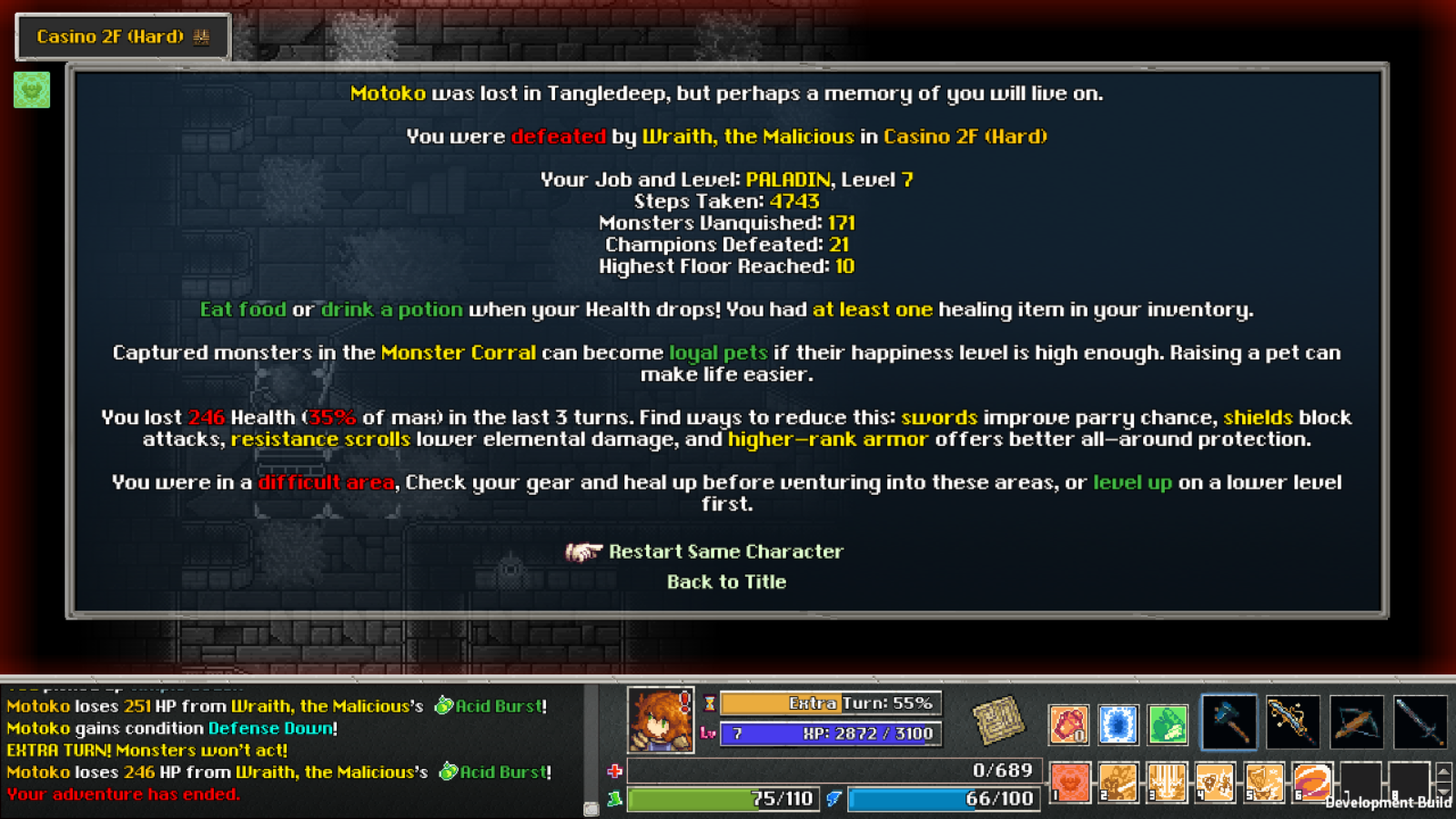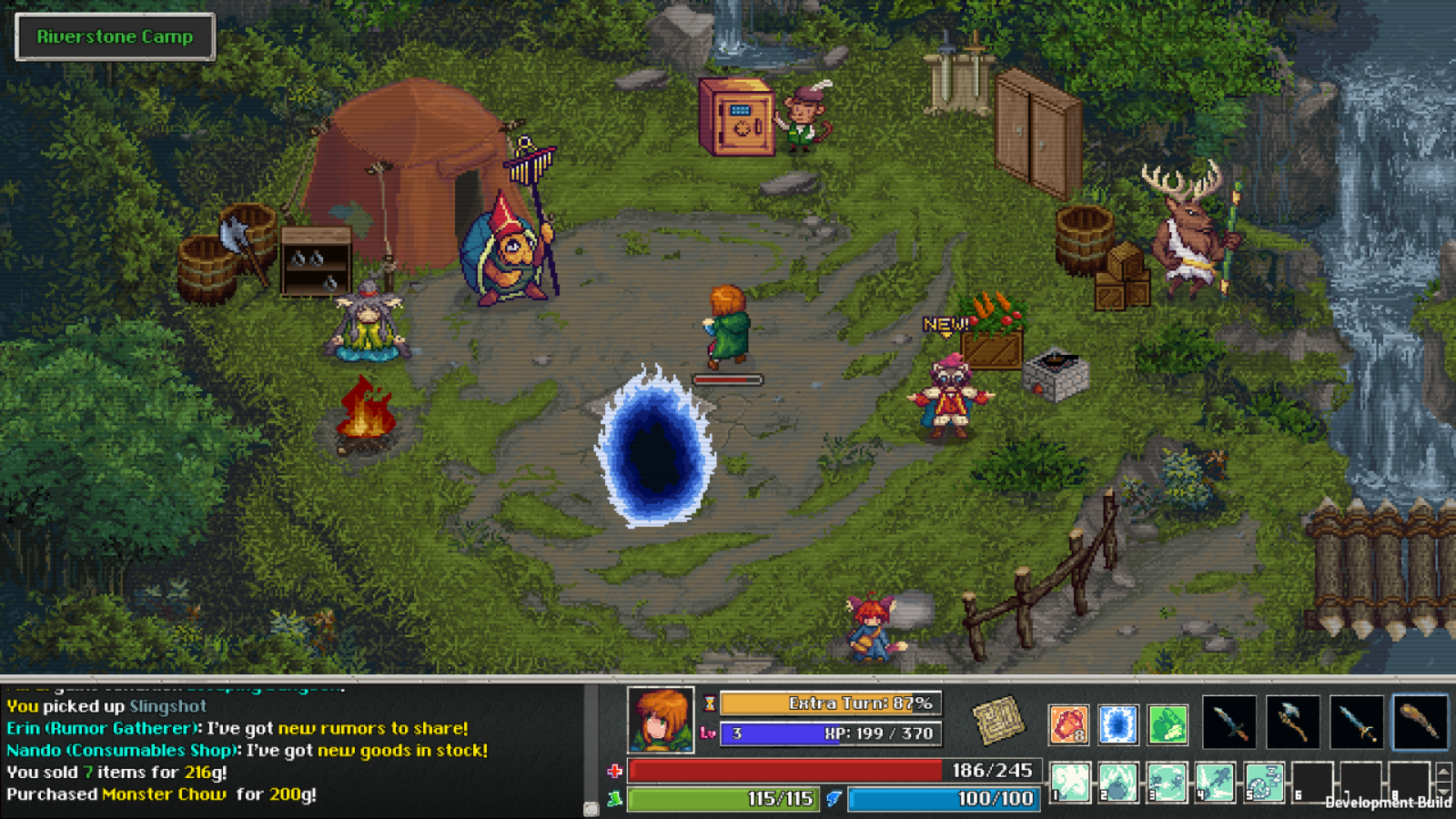Tangledeep is a charming roguelike dungeon crawler from Impact Gameworks with gameplay inspired by games like Diablo and Rogue Legacy and an aesthetic that pays tribute to the 16-bit days of adventure games like Chrono Trigger.
It’s a game that wants you to play; it has little interest in bogging the experience down with exposition, which is all well and good given that the world of Tangledeep doesn’t actually make much sense. The player begins in the small underground settlement of Riverstone Camp and is tasked with finding a way to the surface (an objective as yet unconquered by any previous adventurers, it would seem).
A Roguelike is Only as Good as its Combat
Combat in Tangledeep is fairly straightforward on the surface. It’s a turn-based system on the game’s grid-like maps. Nearly every move, item use, attack, or ability counts as a turn for both the player and the diverse cast of enemies.
At its best, the combat is thoughtful and wonderfully intense. In these moments, every choice becomes its own puzzle as the player attempts to weigh out options and predict the actions of their foes. There is quite a bit of depth and strategy to the game’s more challenging fights, especially as players develop abilities and find useful combinations of attacks.

It’s not all great, though. The game emphasizes the importance of using the right weapon for the right job. When players swap between any of the four weapons they can store in their hot bar, the player’s avatar remains static. There is no visual indication on the character that a change has taken place. In fact, the only actual notification that a change has taken place is a faint blue back-lighting behind the equipped weapon’s icon on the UI.
Tangledeep also automatically switches to ranged weapons when the user clicks on an enemy or destructible object out of melee range, but doesn’t switch back when doing the opposite. This, combined with poor notification of weapon swaps, leads to many situations in which the player is significantly disadvantaged, especially in higher-risk fights where one or two mistakes could end that character’s life.
Permadeath and Difficulty Scaling
The difficulty scaling tends to make leaps at a moment’s notice, which can feel outright unfair in a permadeath game. I died several times after being overwhelmed by tough enemies who seemed to appear out of nowhere, swarming me and leaving me with no feasible way out.
Given my frequent unexpected deaths, I opted to spend a large chunk of my playtime with permadeath turned off. Instead of losing my character upon death, she was sent back to camp, living on to fight another day at the cost of a significant amount of experience and unused ability points. While not the intended method of play from the developer, I found this mode to be far more rewarding in the long term.

Should one choose to pursue the permadeath route, though, Tangledeep presents a good metagame system, helping to drive progression forward. Items and money can be stored for a fee back at camp. Planted trees and corralled pets persist from one character to the next. In general, new characters will be better off than when their predecessors began.
Classes and Systems
Tangledeep features quite a few classes from which the player may choose. While none of them are extraordinary, the unique skills that can be learned from each can be mixed and matched to create fun and diverse combat styles.
In particular, combining the ranged skill set of the Hunter with the graceful attacks of the Sword Dancer yields a character that is nimble and highly elusive, able to do significant damage from afar and generate distance when enemies close the gap.
Tangledeep offers other systems as well. Cooking, farming, pet rearing, and item upgrading are present to various extents. Again, none of these things are revolutionary, but they all offer depth that feels genuine and complimentary to the greater cause of killing things and climbing stairs.
The further you ascend toward the surface, the more important these systems become. There is a lot to offer here, should one choose to invest themselves in parsing out the mechanics of the systems.

Classic Soundtrack
Tangledeep’s soundtrack is stellar, harkening back to classic RPG tunes that sound straight out of early Final Fantasy games. This doesn’t come as too much of a surprise, though. Impact Gameworks’ Lead Developer Andrew Aversa has a long history of quality music including audio work on titles like Soulcalibur V, as well as numerous albums released under the moniker Zircon.

Pros
- Combat is full of exciting moments and important choices
- Permadeath metagame is strong
- Class customization adds tons of depth to combat
- Delightful, nostalgia-inducing soundtrack
Cons
- Combat can feel stilted by a lackluster UI
- Difficulty spikes are inconsistent and can seem unfair
- The world makes very little sense, but the game is about combat and progression, not world building.
Conclusion
Despite my gripes with certain aspects of the game, I want to emphasize that Tangledeep really is an enjoyable game. It’s an entertaining and challenging experience that takes the player back to a time when games were far less forgiving than they are now. It’s not a particularly innovative game. It doesn’t push the boundaries of the roguelike genre or break many rules. What it does do, though, it does quite well. Most of the time.
If you’re a fan of roguelikes and classic dungeon crawlers, the game has a lot to offer in the way of fun combat and depth.
Tangledeep is available on Steam on February 1, 2018. This review was written with a review copy of the game provided by the developer.



